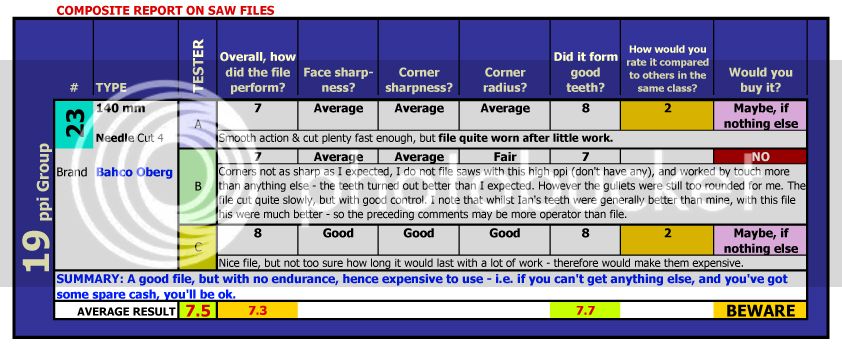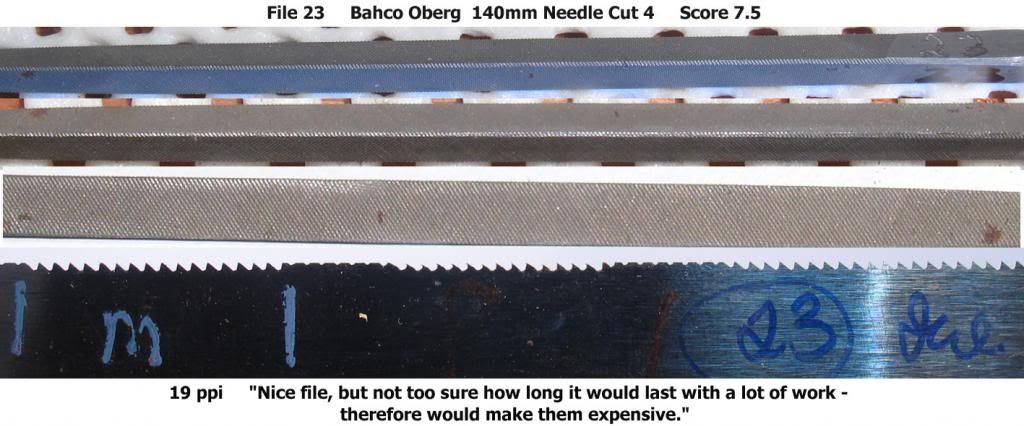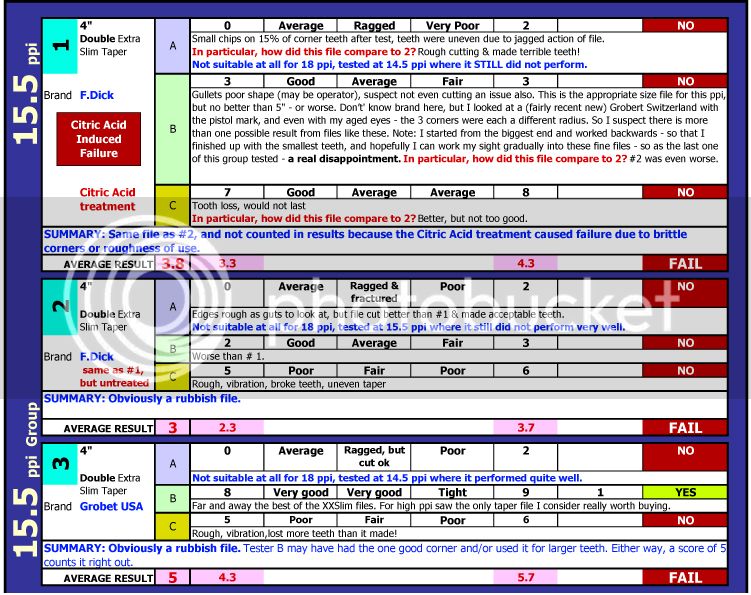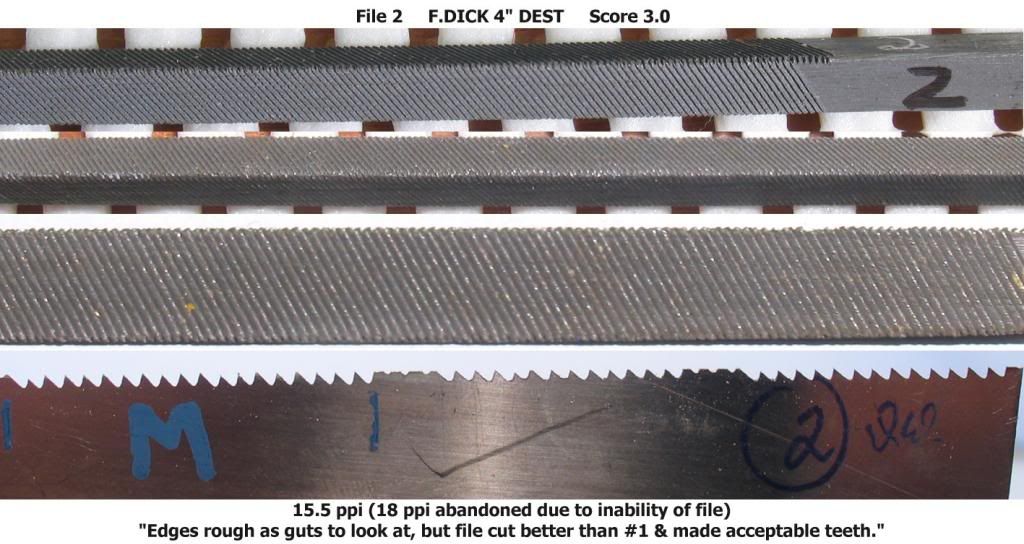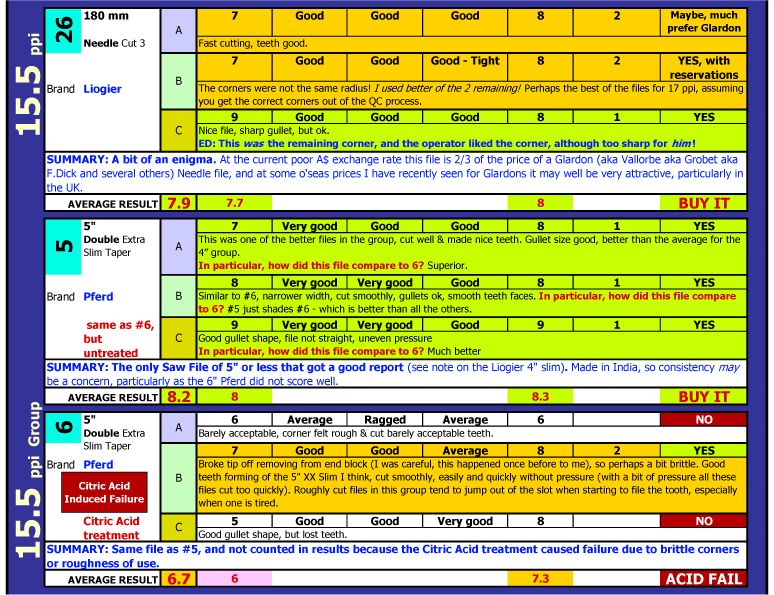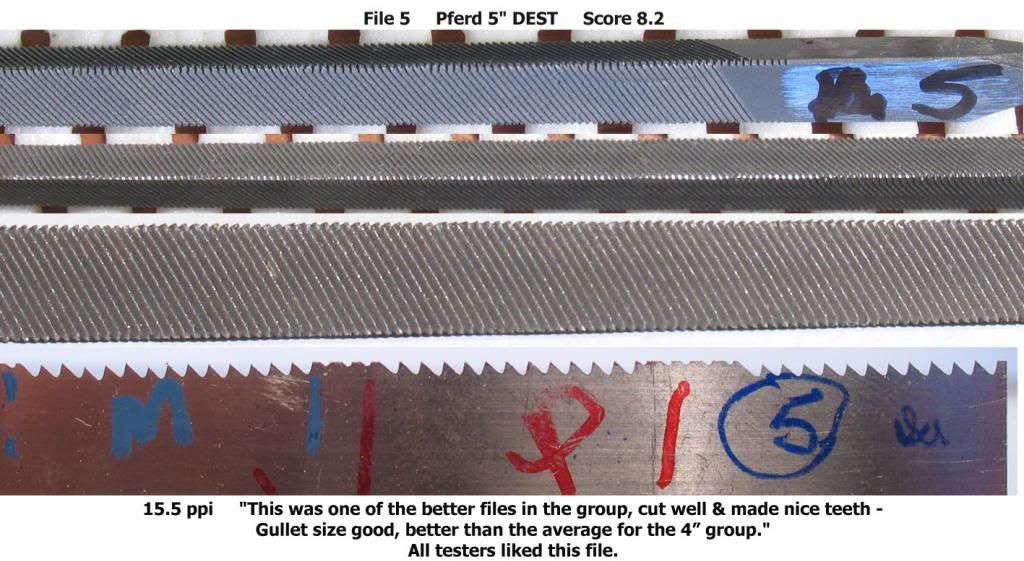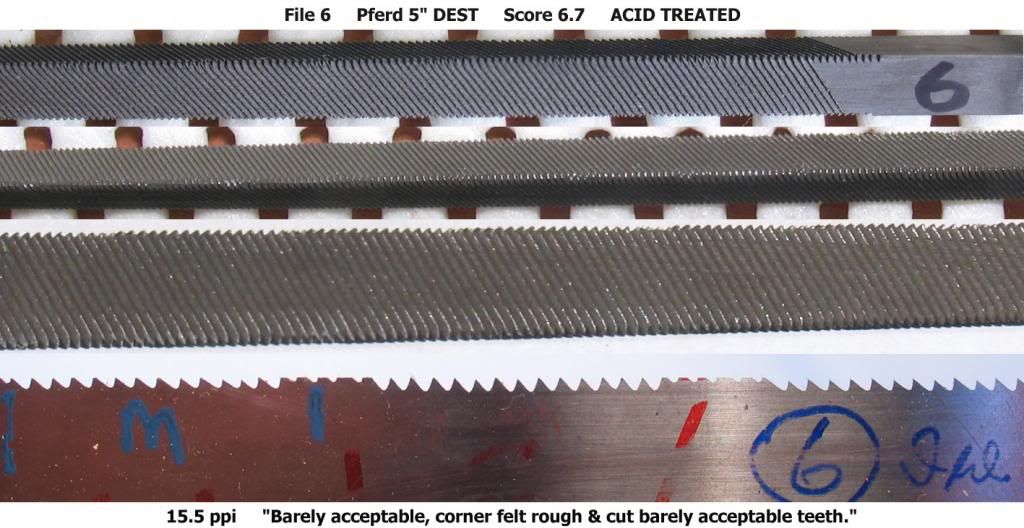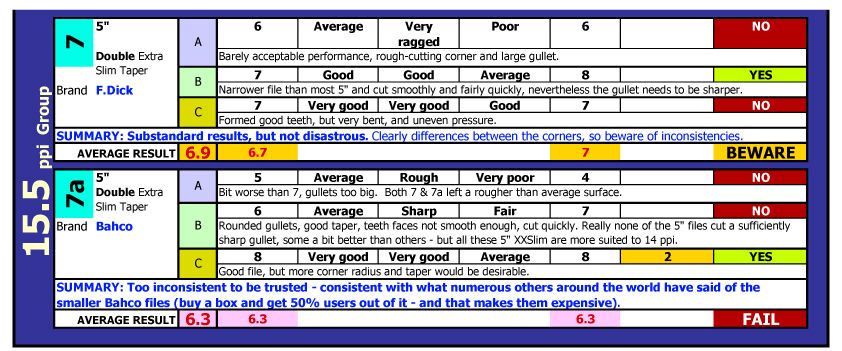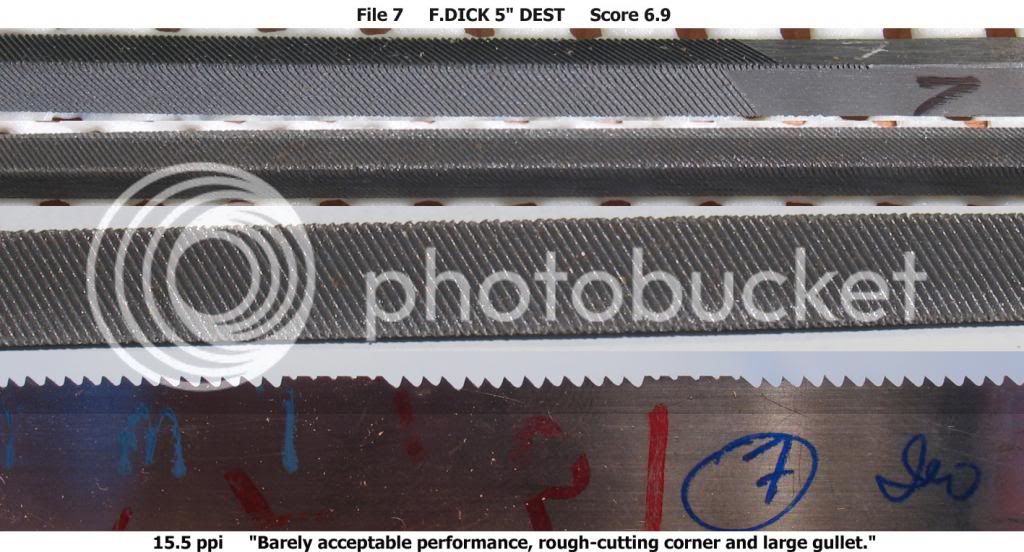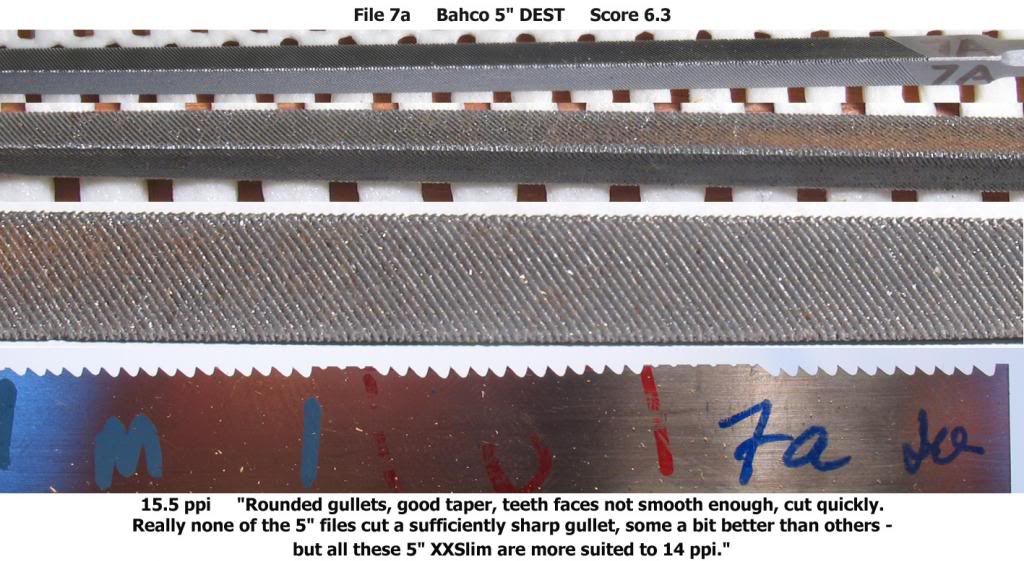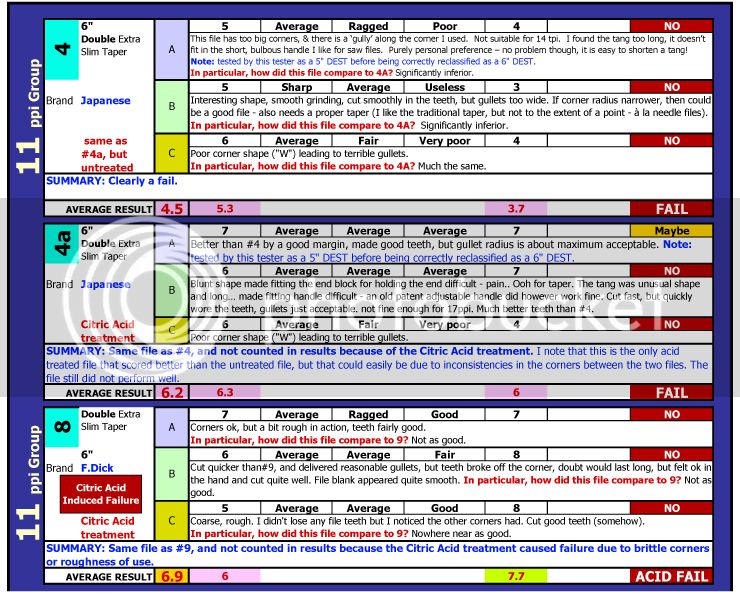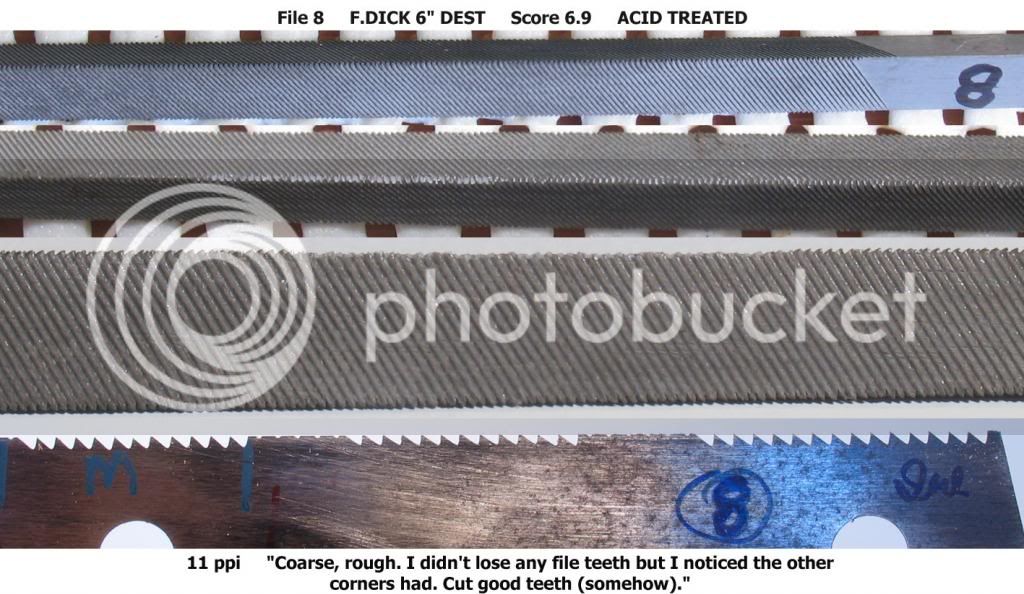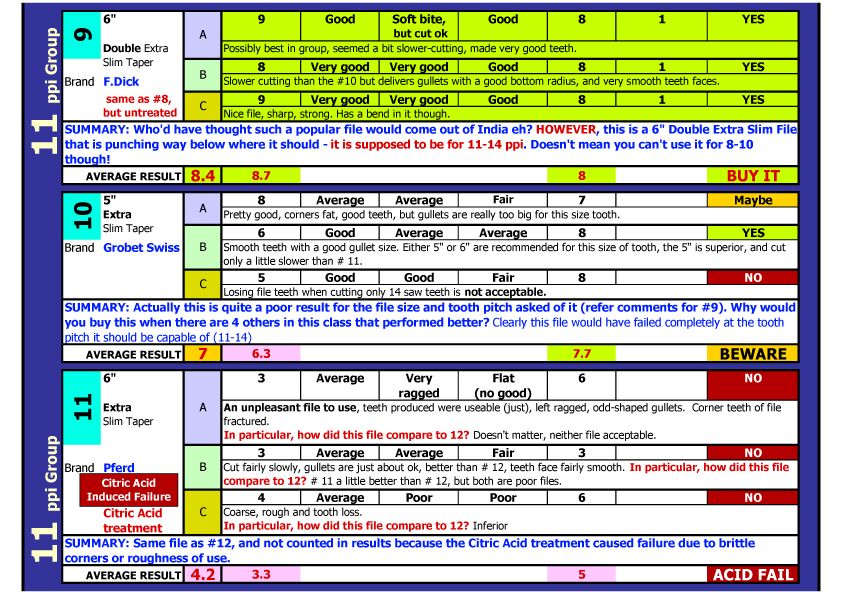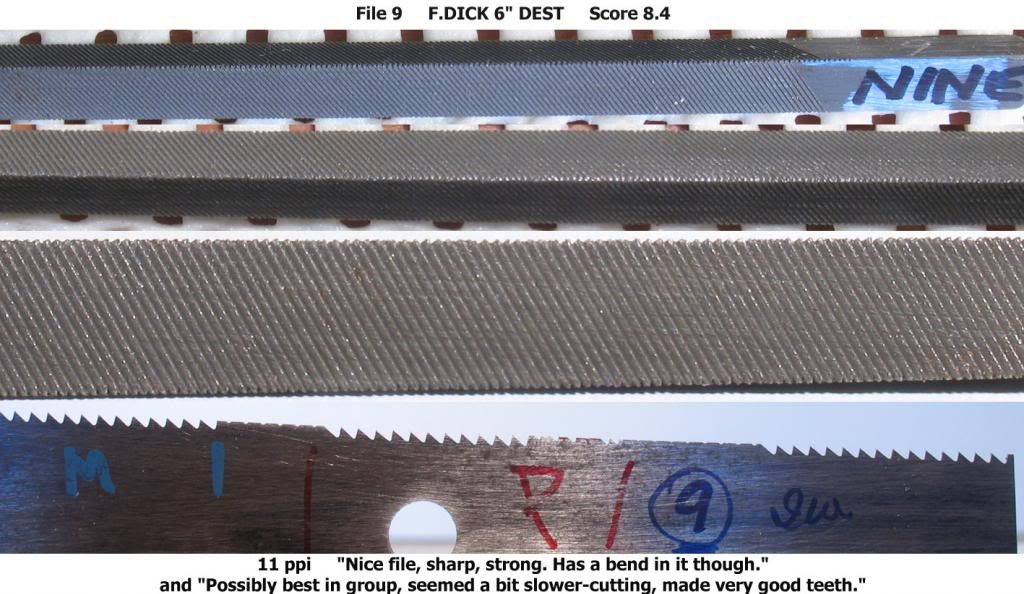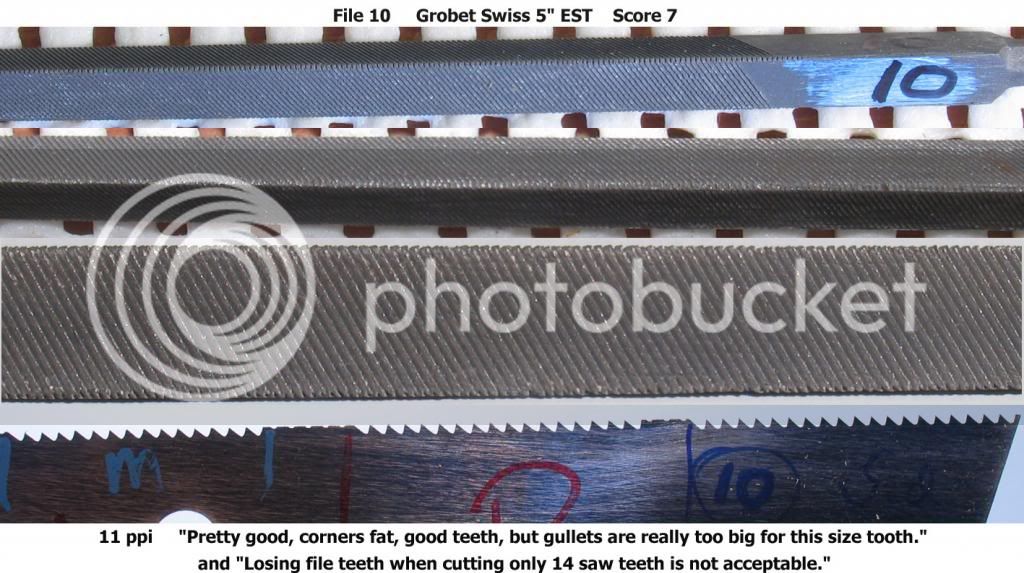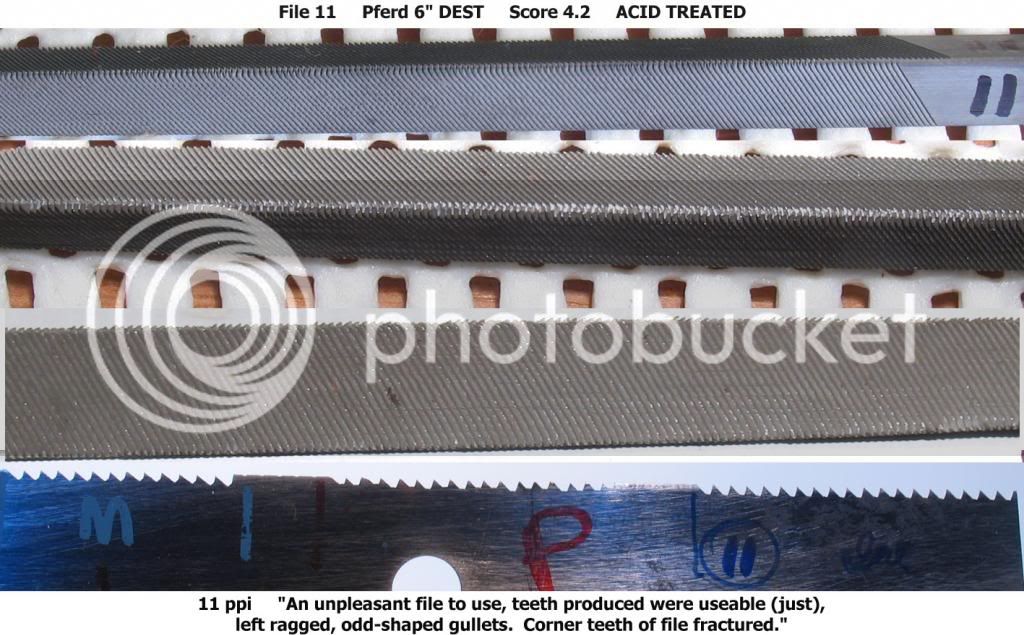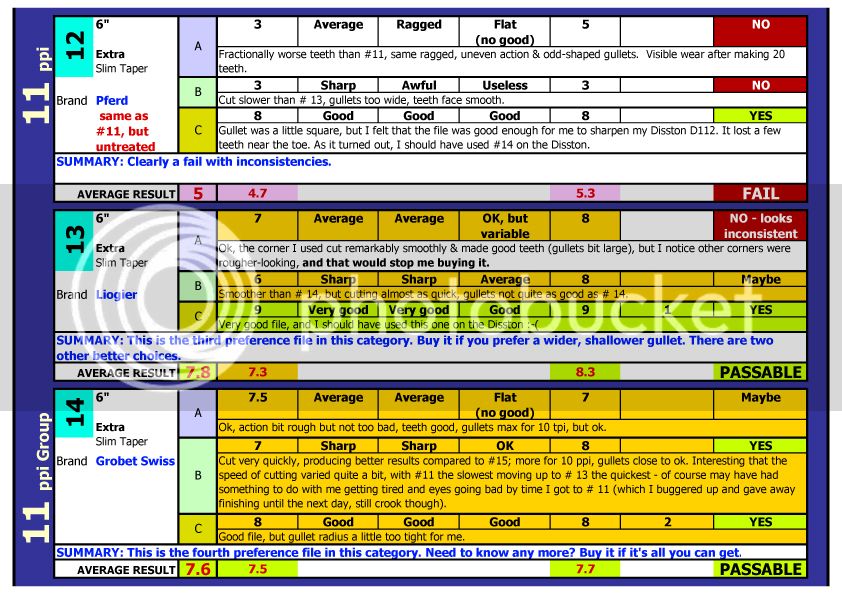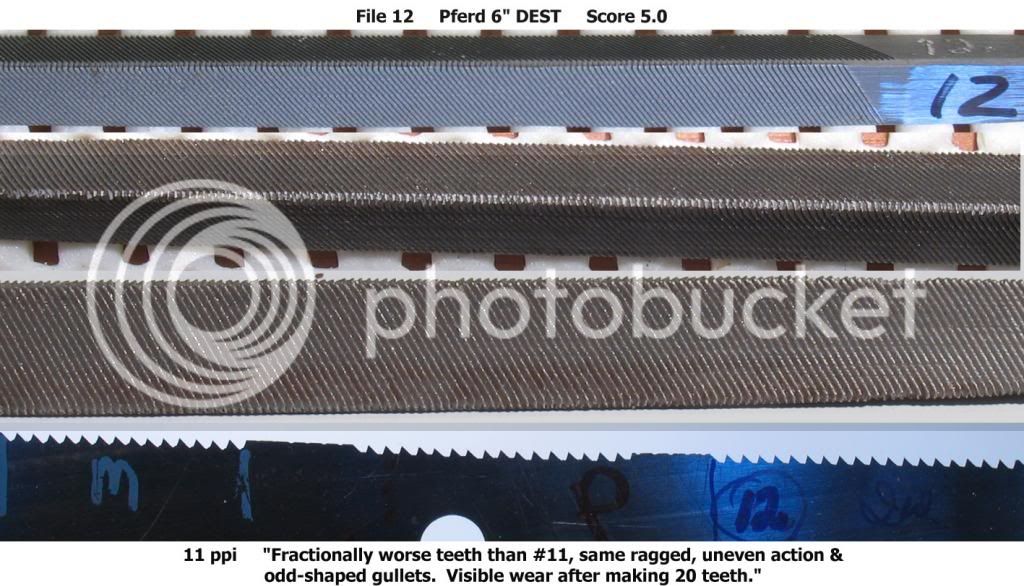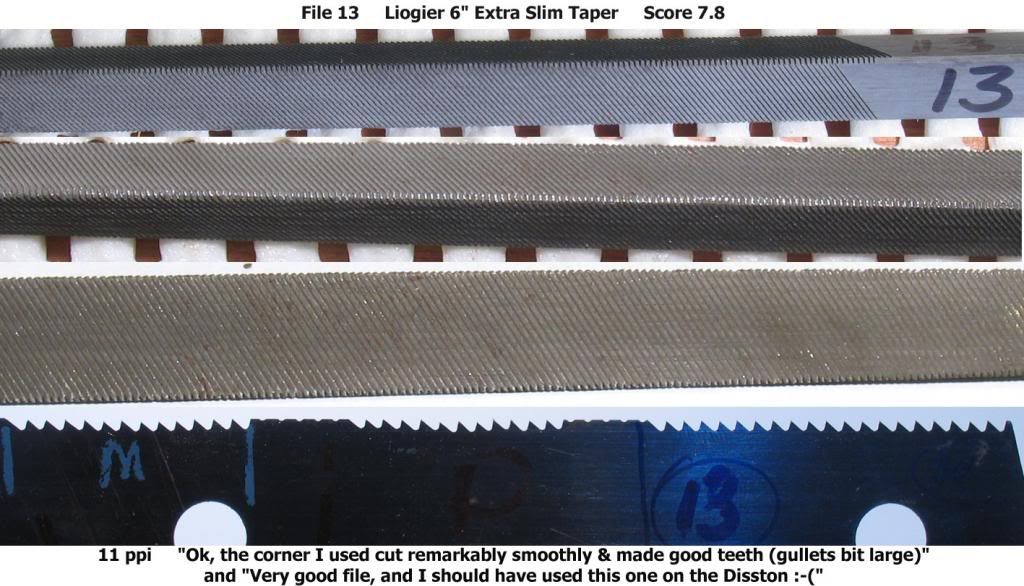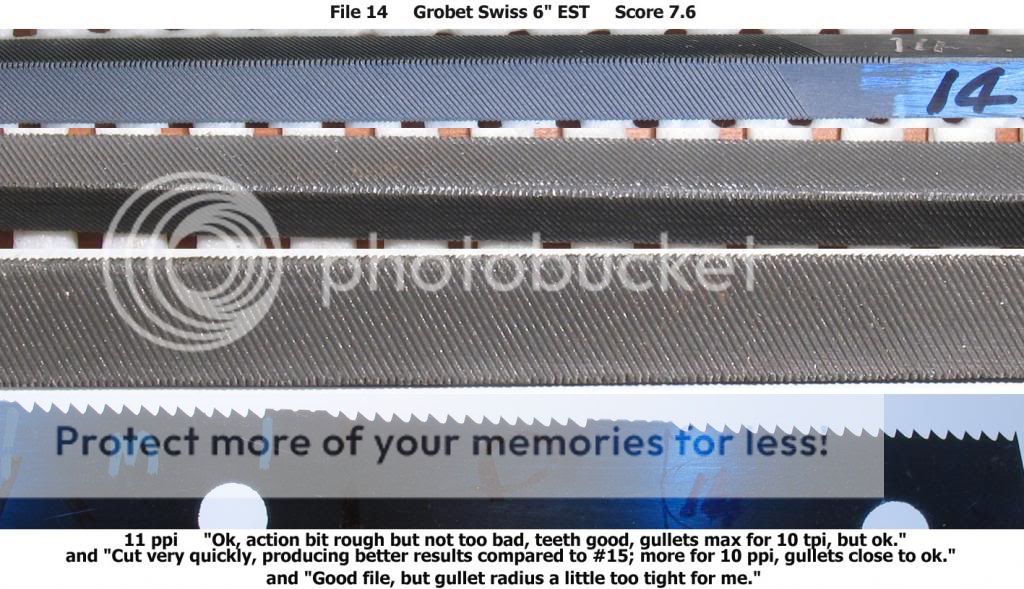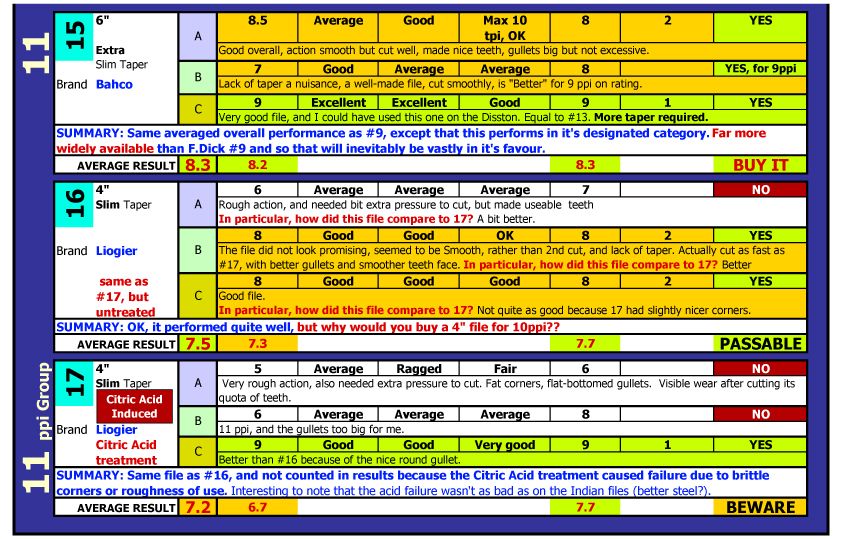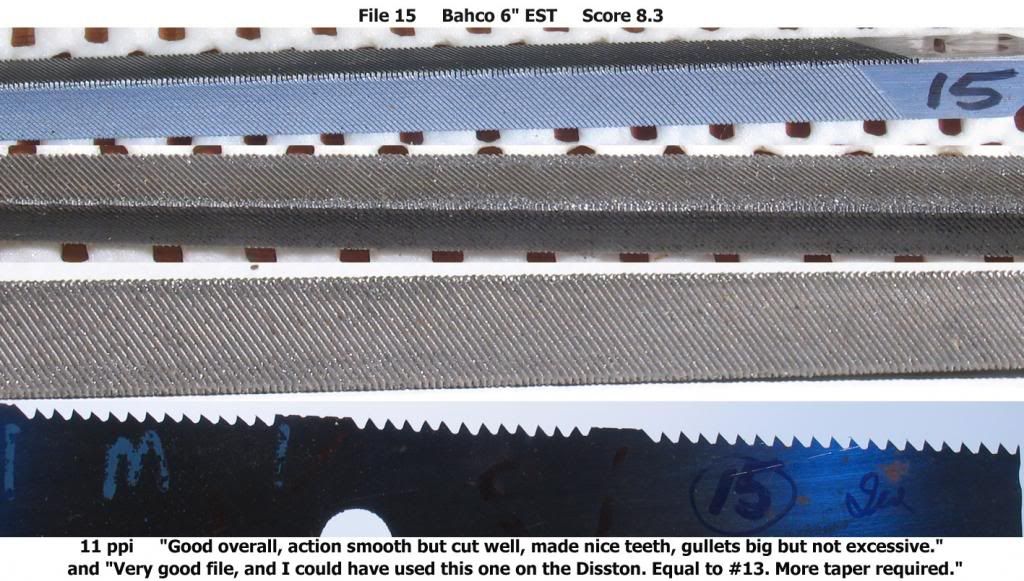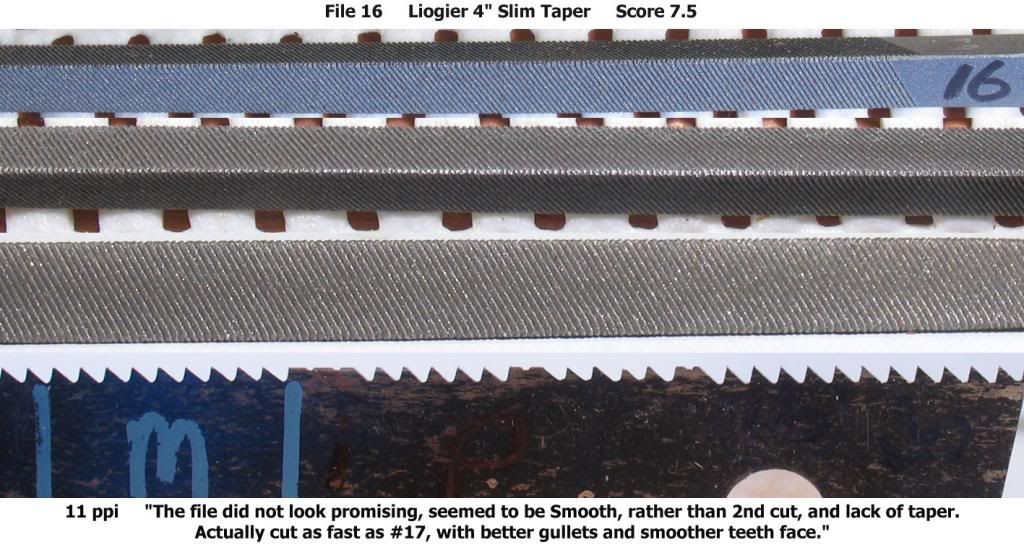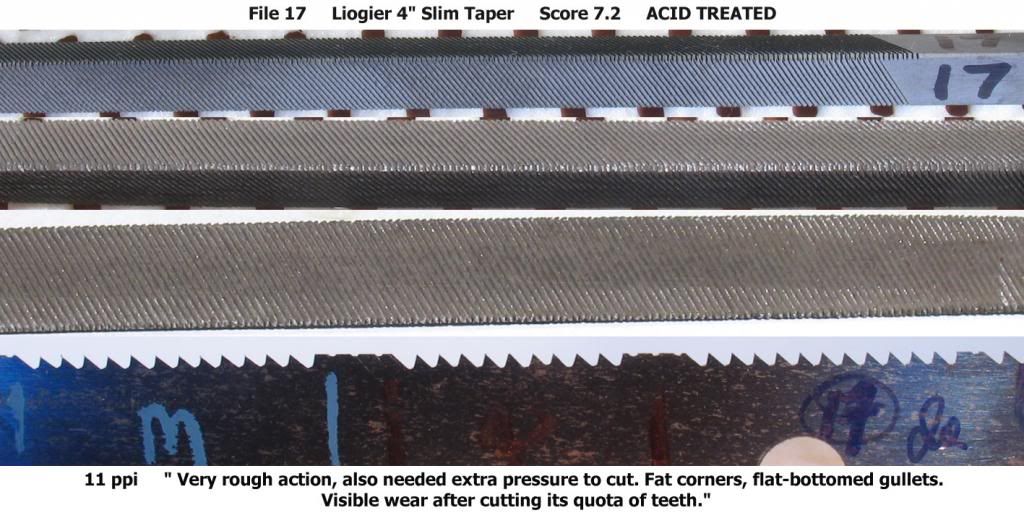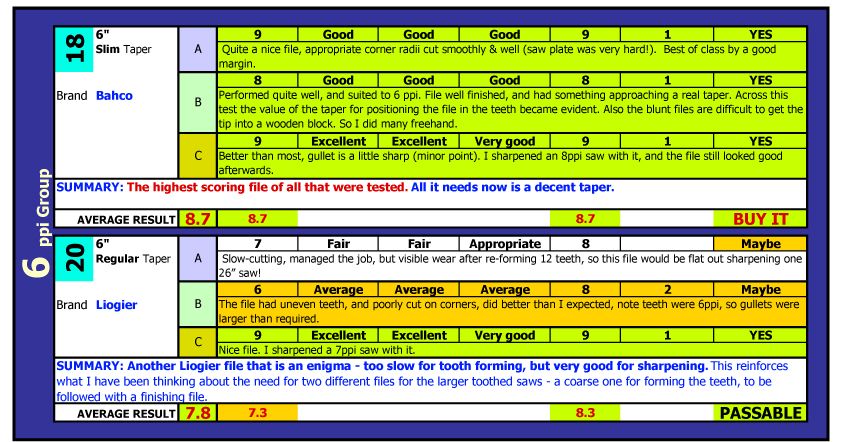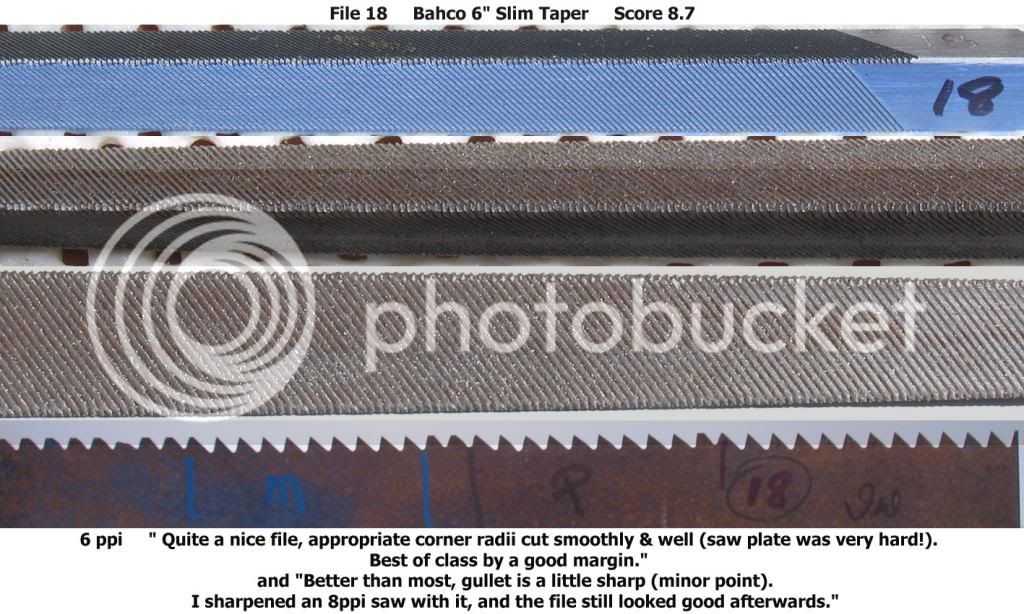FenceFurniture
Established Member
Firstly, a huge thank you to the three testers (Peter, Mark and Ian) who gave a great deal of their time to make this possible. Ian in particular spent additional time marking out the saw plate scraps so that the other two could just hook straight into filing teeth.
PREAMBLE
The three testers all have different perspectives, and that is why I thought they would be a great mix.
Ian Wilkie (IanW) is virtually a professional Saw Maker (could easily be if he chose to – whenever he puts a batch up for sale they sell out within about 30 minutes, and he ends up with more backorders than he put out for sale). He has formed from scratch I’d guess thousands of teeth over the years, and sharpened countless more. Ian didn’t have to do a great deal of research – he has done so much saw filing that it is intuitive, and he has quite a pedigree when it comes to fine woodworking, going back at least a couple of previous generations of very talented chaps. His preference for gullets on finer toothed saws is for less-round and like everybody else, laments the passing of proper Saw Files. In contrast to the other two testers however, he is not a huge fan of the taper, and can take it or leave it (although we might just see about that when proper tapers make their long-awaited return).
Peter Evans (heavansabove) is a serious amateur woodworker and as a very active member of The Traditional Tools Group, he is no stranger to saw sharpening and rehabbing. He likes a fairly sharp gullet in his saws, and is a big fan of the proper taper file. Peter has contributed a great deal of research to this project, including vital information such as the 1942 Nicholson Catalogue which revealed that both Taper and Parallel files were popular choices at that time. Peter also uncovered various other aspects of saw files, such as how the edges of the files are formed before they are cut (they are flattened with a file – not rounded over or “radiused”, and the edges are cut before the faces are).
Mark Aylward (Claw Hama) is a professional woodworker and sculptor. He has been classically trained in the art of filing twice, in two apprenticeships, and so knows his way around a file. He had a strong influence from his father and grandfather who were both professionally involved with timber. It was Mark who was able to describe the function of the taper in a file, and this was a pivotal moment in this project. He also defined why the corners of the file are toothed beyond where the faces are toothed at the toe. We have had long verbal and written discussions throughout this project to date, and that has been of enormous value in bringing it to this point. He also spent many hours researched and digging for the truth. This is a man who likes his gullets a little bit more curved than the other two testers, and I have a feeling that this is because of the size and type of timber that he has worked with – often large slabs of nasty Aussie hardwood with big tooth saws, where a sharp gullet can cause a fracture, and possibly allow for less efficient ejection of dust than a curved gullet might. Mark can probably rightly claim to be the world’s biggest fan of the proper taper file!
The files selected for testing were primarily aimed at those used for saws of 10 ppi and finer. Certain brands, such as Nicholson “Taper” files and Vallorbe Needle files were not included because their current reputation for quality (or a serious lack of) is so well known as to not be worth determining. Some brands were not as well represented as others, and this was largely due to the deep suspicion that many of them come from the same factories and provenance. There was only a certain amount of files that could be purchased and have time from the testers devoted to them.
For larger toothed saws, although there were new teeth formed in saw plate samples, the main purpose was to determine the suitability of the files for sharpening. There is scope for two types of file for larger teeth – a coarser file for rough forming and rapid metal removal, to be followed by a finer file for final shaping and sharpening of the teeth. Finer teeth are much quicker to form and a fine tooth file should do this quickly and efficiently. Therefore the files aimed at these saws were required to be able to do both functions effectively.
Researching has involved many people both here and abroad. Countless websites have been studied and numerous historical publications have been read. However, in all the tens of thousands of words that have been read, there has been no mention whatsoever of the purpose of the taper, or what widths the various file sizes and categories have their edges ground to. This would indicate that the taper and edges were taken for granted as much as a file has to be made of steel and have teeth cut in it to function (although there is at least some information around on those last two aspects). To all those who have assisted in the research – my great thanks.
Citric Acid sharpening was performed on 6 files, and a duplicate untreated file was also included. The testers were asked to pay particular attention to the differences between each file in the various pairs. One of these pairs was the Japanese file, another was a French made Liogier, and the other four pairs were of Indian origin.
In three of the Indian pairs, the acid treated file was a poorer performer, and in one of them it was marginally better, but both files in this pair performed extremely poorly. The acid treated files broke more teeth than the other file almost universally.
In the Japanese pair the acid treated file scored better, but this would appear to be due to better corners on this file, rather than any improvement made by the acid bath.
In the French pair the untreated file scored marginally better than the treated file. Tester C scored the acid file better, but that was because it had a better shaped corner(the specific corner that he used), rather than any improvement made by the acid.
We can assume quite safely that the steel used in the Indian files is inferior to the Japanese and French steel (that’s the only reason they are being produced in India – to get a cheap file). It would appear that acid treatment of lesser quality steel has a greater detrimental impact on it than on better steel. The Japanese acid file scored better than its counterpart (but because of the corner, not the treatment) and the French acid file only scored marginally lower than its mate. In other words, in files of quality steel, the acid didn’t cause it to be a disaster, but equally, it did not aid performance.
In short, the Citric Acid treatment contributed nothing positive whatsoever, and seems to have a very bad effect on lesser quality steel. After I had treated the files I noticed that they felt much “grabbier” (sharper) to the skin, and under a loupe of 8x magnification the treated files looked MUCH sharper and cleaner. Encouraged as I was by this I kept the caveat that this must translate to improved performance, and it did not – quite the opposite.
This leads me to wonder about those who claim that their old files are much improved after an acid bath – are they just being fooled by the grabbiness on their skin (it is a very significant difference in feel)? I wonder if they have ever done any empirical comparisons, because the evidence from this test would appear to be incontrovertible, although the sample was fairly small to make a bold statement, I suppose. Six-nil is pretty convincing though. Perhaps the effect is less noticeable with Engineer’s files where there is not so much concentrated stress on the corners.
Whatever it is, there seems to be no point in putting saw files into an acid bath – it won’t improve the performance of a new file, quite the opposite in fact. For an old file – well, they are worn down and there is no substitute for missing steel! There may be some short term temporary benefit with an old file made from good steel, but that was not the object of this testing. One thing is absolute – the height of the teeth is reduced as the file wears down, and acid treatment can only make them shorter still, certainly not longer.
TESTING CRITERIA
All the labels and logos were ground off the files, and they were each given a unique number. In this way the tests were done “blind”, although files from the sub-continent just look like they are from there, so possibly not hard to work them out. The files were only tested at one tooth pitch, and we were trying to determine the maximum number ppi (i.e. finest tooth) that the files were capable of. Right at the outset, it was noted that none of the 4” DEST files would be capable of 16-19 ppi, and so they were moved into 15.5 ppi. Whilst one of them performed ok at 15.5 the real point is that they are all failures because they are not fit for purpose at their intended tooth pitch range of 15-19ppi.
The Liogier Needle file was supposed to be tested at 19 ppi, but there was a little confusion there, and it was run at 15.5. No matter, being a 3 Square Needle it should be quite capable of finer than 15.5 ppi.
SCORING
<6.5 – FAIL
6.5 to 7.4 – BEWARE, you may or may not get a good one, might be inconsistent within the file itself.
7.5 to 7.9 – PASSABLE, should be ok
8 to 8.9 – GOOD FILE, buy it
9 plus – DOESN’T MATTER, no file scored over 8.7
PREAMBLE
The three testers all have different perspectives, and that is why I thought they would be a great mix.
Ian Wilkie (IanW) is virtually a professional Saw Maker (could easily be if he chose to – whenever he puts a batch up for sale they sell out within about 30 minutes, and he ends up with more backorders than he put out for sale). He has formed from scratch I’d guess thousands of teeth over the years, and sharpened countless more. Ian didn’t have to do a great deal of research – he has done so much saw filing that it is intuitive, and he has quite a pedigree when it comes to fine woodworking, going back at least a couple of previous generations of very talented chaps. His preference for gullets on finer toothed saws is for less-round and like everybody else, laments the passing of proper Saw Files. In contrast to the other two testers however, he is not a huge fan of the taper, and can take it or leave it (although we might just see about that when proper tapers make their long-awaited return).
Peter Evans (heavansabove) is a serious amateur woodworker and as a very active member of The Traditional Tools Group, he is no stranger to saw sharpening and rehabbing. He likes a fairly sharp gullet in his saws, and is a big fan of the proper taper file. Peter has contributed a great deal of research to this project, including vital information such as the 1942 Nicholson Catalogue which revealed that both Taper and Parallel files were popular choices at that time. Peter also uncovered various other aspects of saw files, such as how the edges of the files are formed before they are cut (they are flattened with a file – not rounded over or “radiused”, and the edges are cut before the faces are).
Mark Aylward (Claw Hama) is a professional woodworker and sculptor. He has been classically trained in the art of filing twice, in two apprenticeships, and so knows his way around a file. He had a strong influence from his father and grandfather who were both professionally involved with timber. It was Mark who was able to describe the function of the taper in a file, and this was a pivotal moment in this project. He also defined why the corners of the file are toothed beyond where the faces are toothed at the toe. We have had long verbal and written discussions throughout this project to date, and that has been of enormous value in bringing it to this point. He also spent many hours researched and digging for the truth. This is a man who likes his gullets a little bit more curved than the other two testers, and I have a feeling that this is because of the size and type of timber that he has worked with – often large slabs of nasty Aussie hardwood with big tooth saws, where a sharp gullet can cause a fracture, and possibly allow for less efficient ejection of dust than a curved gullet might. Mark can probably rightly claim to be the world’s biggest fan of the proper taper file!
The files selected for testing were primarily aimed at those used for saws of 10 ppi and finer. Certain brands, such as Nicholson “Taper” files and Vallorbe Needle files were not included because their current reputation for quality (or a serious lack of) is so well known as to not be worth determining. Some brands were not as well represented as others, and this was largely due to the deep suspicion that many of them come from the same factories and provenance. There was only a certain amount of files that could be purchased and have time from the testers devoted to them.
For larger toothed saws, although there were new teeth formed in saw plate samples, the main purpose was to determine the suitability of the files for sharpening. There is scope for two types of file for larger teeth – a coarser file for rough forming and rapid metal removal, to be followed by a finer file for final shaping and sharpening of the teeth. Finer teeth are much quicker to form and a fine tooth file should do this quickly and efficiently. Therefore the files aimed at these saws were required to be able to do both functions effectively.
Researching has involved many people both here and abroad. Countless websites have been studied and numerous historical publications have been read. However, in all the tens of thousands of words that have been read, there has been no mention whatsoever of the purpose of the taper, or what widths the various file sizes and categories have their edges ground to. This would indicate that the taper and edges were taken for granted as much as a file has to be made of steel and have teeth cut in it to function (although there is at least some information around on those last two aspects). To all those who have assisted in the research – my great thanks.
Citric Acid sharpening was performed on 6 files, and a duplicate untreated file was also included. The testers were asked to pay particular attention to the differences between each file in the various pairs. One of these pairs was the Japanese file, another was a French made Liogier, and the other four pairs were of Indian origin.
In three of the Indian pairs, the acid treated file was a poorer performer, and in one of them it was marginally better, but both files in this pair performed extremely poorly. The acid treated files broke more teeth than the other file almost universally.
In the Japanese pair the acid treated file scored better, but this would appear to be due to better corners on this file, rather than any improvement made by the acid bath.
In the French pair the untreated file scored marginally better than the treated file. Tester C scored the acid file better, but that was because it had a better shaped corner(the specific corner that he used), rather than any improvement made by the acid.
We can assume quite safely that the steel used in the Indian files is inferior to the Japanese and French steel (that’s the only reason they are being produced in India – to get a cheap file). It would appear that acid treatment of lesser quality steel has a greater detrimental impact on it than on better steel. The Japanese acid file scored better than its counterpart (but because of the corner, not the treatment) and the French acid file only scored marginally lower than its mate. In other words, in files of quality steel, the acid didn’t cause it to be a disaster, but equally, it did not aid performance.
In short, the Citric Acid treatment contributed nothing positive whatsoever, and seems to have a very bad effect on lesser quality steel. After I had treated the files I noticed that they felt much “grabbier” (sharper) to the skin, and under a loupe of 8x magnification the treated files looked MUCH sharper and cleaner. Encouraged as I was by this I kept the caveat that this must translate to improved performance, and it did not – quite the opposite.
This leads me to wonder about those who claim that their old files are much improved after an acid bath – are they just being fooled by the grabbiness on their skin (it is a very significant difference in feel)? I wonder if they have ever done any empirical comparisons, because the evidence from this test would appear to be incontrovertible, although the sample was fairly small to make a bold statement, I suppose. Six-nil is pretty convincing though. Perhaps the effect is less noticeable with Engineer’s files where there is not so much concentrated stress on the corners.
Whatever it is, there seems to be no point in putting saw files into an acid bath – it won’t improve the performance of a new file, quite the opposite in fact. For an old file – well, they are worn down and there is no substitute for missing steel! There may be some short term temporary benefit with an old file made from good steel, but that was not the object of this testing. One thing is absolute – the height of the teeth is reduced as the file wears down, and acid treatment can only make them shorter still, certainly not longer.
TESTING CRITERIA
All the labels and logos were ground off the files, and they were each given a unique number. In this way the tests were done “blind”, although files from the sub-continent just look like they are from there, so possibly not hard to work them out. The files were only tested at one tooth pitch, and we were trying to determine the maximum number ppi (i.e. finest tooth) that the files were capable of. Right at the outset, it was noted that none of the 4” DEST files would be capable of 16-19 ppi, and so they were moved into 15.5 ppi. Whilst one of them performed ok at 15.5 the real point is that they are all failures because they are not fit for purpose at their intended tooth pitch range of 15-19ppi.
The Liogier Needle file was supposed to be tested at 19 ppi, but there was a little confusion there, and it was run at 15.5. No matter, being a 3 Square Needle it should be quite capable of finer than 15.5 ppi.
SCORING
<6.5 – FAIL
6.5 to 7.4 – BEWARE, you may or may not get a good one, might be inconsistent within the file itself.
7.5 to 7.9 – PASSABLE, should be ok
8 to 8.9 – GOOD FILE, buy it
9 plus – DOESN’T MATTER, no file scored over 8.7





